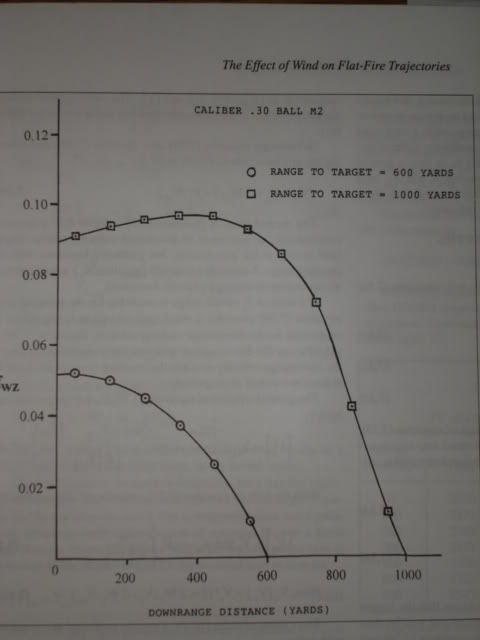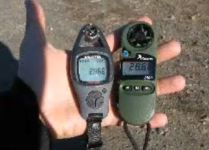G
You are using an out of date browser. It may not display this or other websites correctly.
You should upgrade or use an alternative browser.
You should upgrade or use an alternative browser.
A
abintx
Guest
gt40 ...
What's your definition of long range ??? What class of shooting are you engaged in ???
What's your definition of long range ??? What class of shooting are you engaged in ???
Wind Speed
I believe they are meters that will tell you the wind speed and direction if used properly.
The problem as I see it is the reading is at the gun and not lets say "across the course".
They may be of added value if you already knew how to read mirage at distances.
It is my experence that the wind at the rifle may have less effect than the wind down range.
I believe they are meters that will tell you the wind speed and direction if used properly.
The problem as I see it is the reading is at the gun and not lets say "across the course".
They may be of added value if you already knew how to read mirage at distances.
It is my experence that the wind at the rifle may have less effect than the wind down range.
GT40
The 600/1,000 yard guys set them up on a tri-pod in front of there benches.If your last sighter was taken in 8 mph wind and was dead center when you get the command to fire on the record target you can look at the wind speed and fire when it is at 8 mph again.
You can hang a wind direction indicator off of the tri-pod to see if the wind is blowing in the same direction as well.
In my opinion a 10 mph wind has more affect at the gun than a 10 mph wind anywhere else downrange in moving the bullet.
Waterboy aka Lynn
The 600/1,000 yard guys set them up on a tri-pod in front of there benches.If your last sighter was taken in 8 mph wind and was dead center when you get the command to fire on the record target you can look at the wind speed and fire when it is at 8 mph again.
You can hang a wind direction indicator off of the tri-pod to see if the wind is blowing in the same direction as well.
In my opinion a 10 mph wind has more affect at the gun than a 10 mph wind anywhere else downrange in moving the bullet.
Waterboy aka Lynn
T
Tony Shankle
Guest
Looks like a JDC on the left and a Kestrel 2000 on the right. I use the 4500NV Kestrel... http://www.ambientweather.com/ke845nv.html
In my opinion a very important tool.
In my opinion a very important tool.
L
Louis Boyd
Guest
GT40
In my opinion a 10 mph wind has more affect at the gun than a 10 mph wind anywhere else downrange in moving the bullet.
Waterboy aka Lynn
That does seem intuitve but it's not necessarily true. It depends on the profile of the bullet velocity vs distance over the trajectory to the target. Chapter 7, "The effect of wind on flat fire trajectories" in Robert McCoy's book "Modern Exterior Ballistics" has a discussion of the sensitivity to wind versus downrange distance. It's a good read. This graph gives an example of a case where the location of peak wind sensitivity is not at the shooter's location.

Last edited by a moderator:
L
Louis Boyd
Guest
Sorry, my photo clipped that. The Y axis lable is "fwz" with the wz as a subscript. and the text calls that the "crosswind weighting factor". Its units are seconds of time. The math to calculate it is too complex to print here, but this descrition may help.What's the label on the "Y" axis of that chart?
" The utility of the crosswind weighting factor method is based on the fact that the weighting factor represents the local sensitivity of the trajectory to crosswind."
This is basicly using Didion's "lag time" equation divided into subintervals to reflect the effect at the target of wind in the subintervals. I can only recommend studying the chapter. It's eight pages, about half equations including some integral calculus. Most of the math is the same as is used in McCoy's McTraj computer programs which is the basis of most avaiable small arms ballistics programs, but none of the progrrams I'm aware of bother to display the fwz function.
I think one can calculate the fwz function without too much difficulty using a typical ballistics program. Just use the program to show the velocity at intervals over the path to the target and the total wind deflection for that shot. (most programs do that). Then make a series of simulated shots using the velocity and distance along that path as though that were complete shots fired at the loaction and velocity at each interval and recored the wind deflection for each of those shorter shots. Then to subtract the defletion of each of those simulate shots from the deflection of the previoius deflection t to show the effect that each subinterval adds. How fine you make the intervals doesn't really matter. Every hundred yards is probably sufficient for practical purposes. I also think you can demosntrate the effects of variable downrange crosswind with the same technique though I haven't tested it enough to be sure it works correctly.
CYanchycki
Club Coordinator
I shoot
my Rem 700 6BR from 300 out to 1000 yards just for Sh+++ and giggles at the farm. I shoot from the highest hill across to the other hills on the farm.
Thursday I went out to visit my parents and brought my rifle along with me and my load of 95gr Bergers a top a charge of H4895.
I pulled my Kestrel 3500NV to see what the gusts were on top to give me a idea of how much windage I would have to dial in. Gusts were slightly at or above the 20 MPH mark coming at about a 45 deg angle headwind to the bullet path. I was on the gong with my third shot. I missed only once after that with a strong cross wind.
Kestrels are your FRIEND. They help in finding the target way out there as far as I am concerned. In regards to temp and humidity reading I set it outside alongside a cheap outdoor dig ithermometer from Canadian Tire and they were so close in readings it hurt.
Calvin
my Rem 700 6BR from 300 out to 1000 yards just for Sh+++ and giggles at the farm. I shoot from the highest hill across to the other hills on the farm.
Thursday I went out to visit my parents and brought my rifle along with me and my load of 95gr Bergers a top a charge of H4895.
I pulled my Kestrel 3500NV to see what the gusts were on top to give me a idea of how much windage I would have to dial in. Gusts were slightly at or above the 20 MPH mark coming at about a 45 deg angle headwind to the bullet path. I was on the gong with my third shot. I missed only once after that with a strong cross wind.
Kestrels are your FRIEND. They help in finding the target way out there as far as I am concerned. In regards to temp and humidity reading I set it outside alongside a cheap outdoor dig ithermometer from Canadian Tire and they were so close in readings it hurt.
Calvin
B
benenglish
Guest
Good graph.That does seem intuitve but it's not necessarily true. It depends on the profile of the bullet velocity vs distance over the trajectory to the target. Chapter 7, "The effect of wind on flat fire trajectories" in Robert McCoy's book "Modern Exterior Ballistics" has a discussion of the sensitivity to wind versus downrange distance. It's a good read. This graph gives an example of a case where the location of peak wind sensitivity is not at the shooter's location.

The 1000-yard plot is especially interesting. 30 M2 ball throws a bullet of about 150 grains at about 2800 fps. (I use "about" because different references say different things and I don't want to get bogged down in minor irrelevancies.) The chart shows that said bullet is most susceptible to wind deflection at about 400-500 yards. At that range, the bullet speed has dropped to about 1800 fps or so. The exact figure isn't important; what's important to understanding wind drift is the neighborhood we're now in.
Wind drift isn't a function of speed or time of flight. It's a function of the rate of change of bullet velocity. As a bullet enters the transsonic range, it sheds speed more quickly and drifts more. The phenomenon starts around 2300 fps. As a bullet slows down below that speed, the amount of wind drift increases more than time of flight would seem to suggest. The effect is worst at about 1700 fps. Then the process reverses itself and the bullet sheds velocity less quickly as speed drops further. Thus, wind drift then becomes less as the bullet slows from 1700 to about 900 fps.
Wind drift is about the same at 900 fps as it is at 2300 fps. In between is worse than the extremes.
So your chart shows exactly that. The bullet impact is more influenced by the wind at the 400-500 yard distance than either before or after. If the target is 600 yards away, this may not make much difference. But if the target is 1000 yards away, the deflection that occurred halfway to the target has much more time to push the bullet away from center.
If long range shooters wanted to minimize wind drift and didn't care about the ridiculous elevation problems that would crop up, they'd be better off launching 30 caliber 300-grain VLDs at 950 feet per second.
Obviously, that's not going to happen. But it does go to prove something I constantly harp about: Studying ballistics is taking a walk in the land of the weird.


